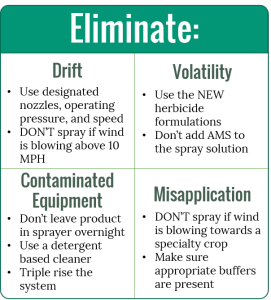As we wrap up 2017, it’s also time to start planning for 2018. One of the most important decisions a grower can make is which varieties they will plant. An important part of selecting a variety is selecting which (if any) herbicide tolerance is used.
If you decide to use the dicamba tolerance technology (Xtend beans) on your farm in 2018, it is essential you understand the label. Last week, the EPA announced changes would be made to the Xtendimax, Fexapan, and Engenia labels for the 2018 season. These changes will help to minimize the potential for drift on neighboring crops while still taking advantage of the weed control these products provide.
EPA worked with states, land-grant universities, and the pesticide manufacturers to ensure the changes reflect the best, on-the-ground information and will help address the problems seen in the Midsouth this season.
The label changes include:
- Classifying products as “restricted use,” permitting only certified applicators with special training, and those under their supervision, to apply them; dicamba-specific training for all certified applicators to reinforce proper use;
- Requiring farmers to maintain specific records regarding the use of these products to improve compliance with label restrictions;
- Limiting applications to when maximum wind speeds are below 10 mph to reduce potential spray drift;
- Reducing the times during the day when applications can occur;
- Including tank clean-out language to prevent cross contamination; and
- Enhancing susceptible crop language and record keeping with sensitive crop registries to increase awareness of risk to especially sensitive crops nearby.
More details will be available on the individual product labels and all three companies have agreed to a process to get these labels into the hands of growers in time for the 2018 season.
In terms of the future beyond 2018, it’s important to remember that the original registration for these over-the-top dicamba products expires after the 2018 growing season. The EPA has said they will closely monitor how these changes affect misapplication and will use that information to decide the fate of these products after 2018. Therefore, it is essential growers use this technology in a responsible manner and do everything in their power prevent off-target damage to ensure this important tool remains available for years to come.








